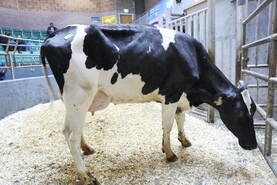The Ulster Grassland Society (UGS) held its spring event this week on the farm of Desmond and Alastair Taylor, who operate a high-yielding dairy herd of 230 cows near Ballymoney.
Cows calve year-round, with between 40 to 45 replacement heifers entering the herd annually.
However, this autumn there are 90 in-calf heifers joining the herd, with the plan to increase numbers to around 280 cows to fully utilise housing.
Cows are kept inside, with construction of a new cubicle house finished this past winter.
The new shed now holds 200 cows, split in two groups depending on the stage of lactation. All cows are milked through four robots, which were installed in the new shed in January.
The move to robotic milking came as Alastair wanted to increase the herd, and push towards three times-a-day milking to maximise yields.
Cow performance
Cows averaged 9,500l last year, with 3t of concentrate fed per cow, giving 2,500l from forage. Butterfat was 4.15%, protein 3.24%, with SCC below 200.
Margin over feed this spring was £6.31/cow, with cows currently averaging 32.6l/day through the robots at 4.25% butterfat, 3.2% protein, and a supplementary feed rate of 0.37kg/l of milk produced.
Cows are fed a TMR of 10kg wholecrop, 27kg of first-cut silage, 0.3kg straw, 4kg of home-grown crimped barley and 2.5kg of a protein balancer.
They are then topped up according to yield via the robots, starting from 2kg of a 16% protein nut, which increases to 8kg by 29 days in milk.
From 30 to 100 days in milk, cows are built up to 11.9kg of concentrate, with a 20% protein nut introduced.
After 100 days in milk, cows are maintained on 11.9kg of concentrate and gradually reduced as lactation tails off.
Other enterprises
There are also two poultry houses and a 125kW anaerobic digestion (AD) plant on the farm.
Animal waste from the dairy cows and poultry is utilised by the AD plant, which in turn provides all power to run the dairy unit and the poultry houses.
The poultry houses are also heated by hot water produced from the AD plant.
The digestate produced is then used to grow grass and crops, with analysis indicating that 1,000 gallons provide 30 units of nitrogen, meaning very little bagged fertiliser has to be purchased.
With 30% of energy produced consumed on-farm, the remaining 70% of power is exported to the grid.
Read more
Watch: a fertility master class in Moorepark
Dairy markets: UK milk production surges ahead for March
The Ulster Grassland Society (UGS) held its spring event this week on the farm of Desmond and Alastair Taylor, who operate a high-yielding dairy herd of 230 cows near Ballymoney.
Cows calve year-round, with between 40 to 45 replacement heifers entering the herd annually.
However, this autumn there are 90 in-calf heifers joining the herd, with the plan to increase numbers to around 280 cows to fully utilise housing.
Cows are kept inside, with construction of a new cubicle house finished this past winter.
The new shed now holds 200 cows, split in two groups depending on the stage of lactation. All cows are milked through four robots, which were installed in the new shed in January.
The move to robotic milking came as Alastair wanted to increase the herd, and push towards three times-a-day milking to maximise yields.
Cow performance
Cows averaged 9,500l last year, with 3t of concentrate fed per cow, giving 2,500l from forage. Butterfat was 4.15%, protein 3.24%, with SCC below 200.
Margin over feed this spring was £6.31/cow, with cows currently averaging 32.6l/day through the robots at 4.25% butterfat, 3.2% protein, and a supplementary feed rate of 0.37kg/l of milk produced.
Cows are fed a TMR of 10kg wholecrop, 27kg of first-cut silage, 0.3kg straw, 4kg of home-grown crimped barley and 2.5kg of a protein balancer.
They are then topped up according to yield via the robots, starting from 2kg of a 16% protein nut, which increases to 8kg by 29 days in milk.
From 30 to 100 days in milk, cows are built up to 11.9kg of concentrate, with a 20% protein nut introduced.
After 100 days in milk, cows are maintained on 11.9kg of concentrate and gradually reduced as lactation tails off.
Other enterprises
There are also two poultry houses and a 125kW anaerobic digestion (AD) plant on the farm.
Animal waste from the dairy cows and poultry is utilised by the AD plant, which in turn provides all power to run the dairy unit and the poultry houses.
The poultry houses are also heated by hot water produced from the AD plant.
The digestate produced is then used to grow grass and crops, with analysis indicating that 1,000 gallons provide 30 units of nitrogen, meaning very little bagged fertiliser has to be purchased.
With 30% of energy produced consumed on-farm, the remaining 70% of power is exported to the grid.
Read more
Watch: a fertility master class in Moorepark
Dairy markets: UK milk production surges ahead for March






 This is a subscriber-only article
This is a subscriber-only article









SHARING OPTIONS: